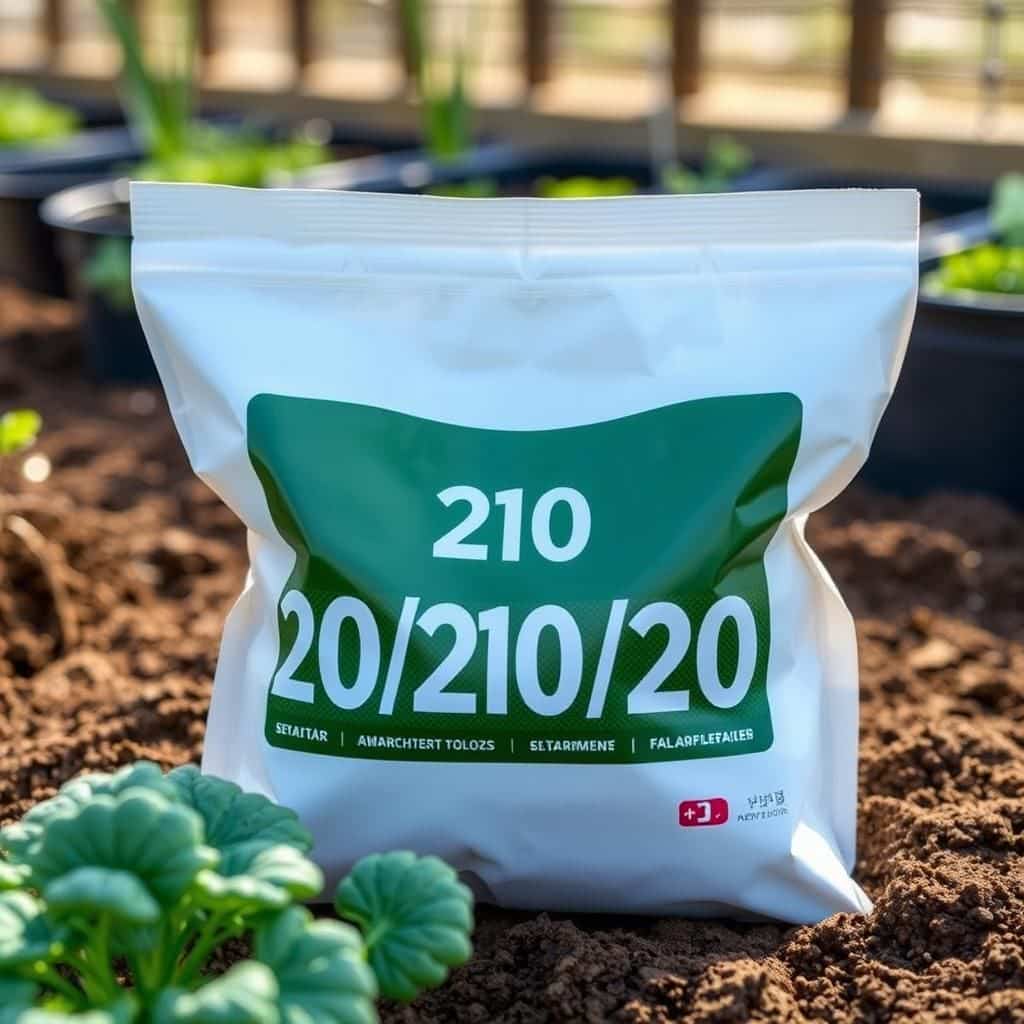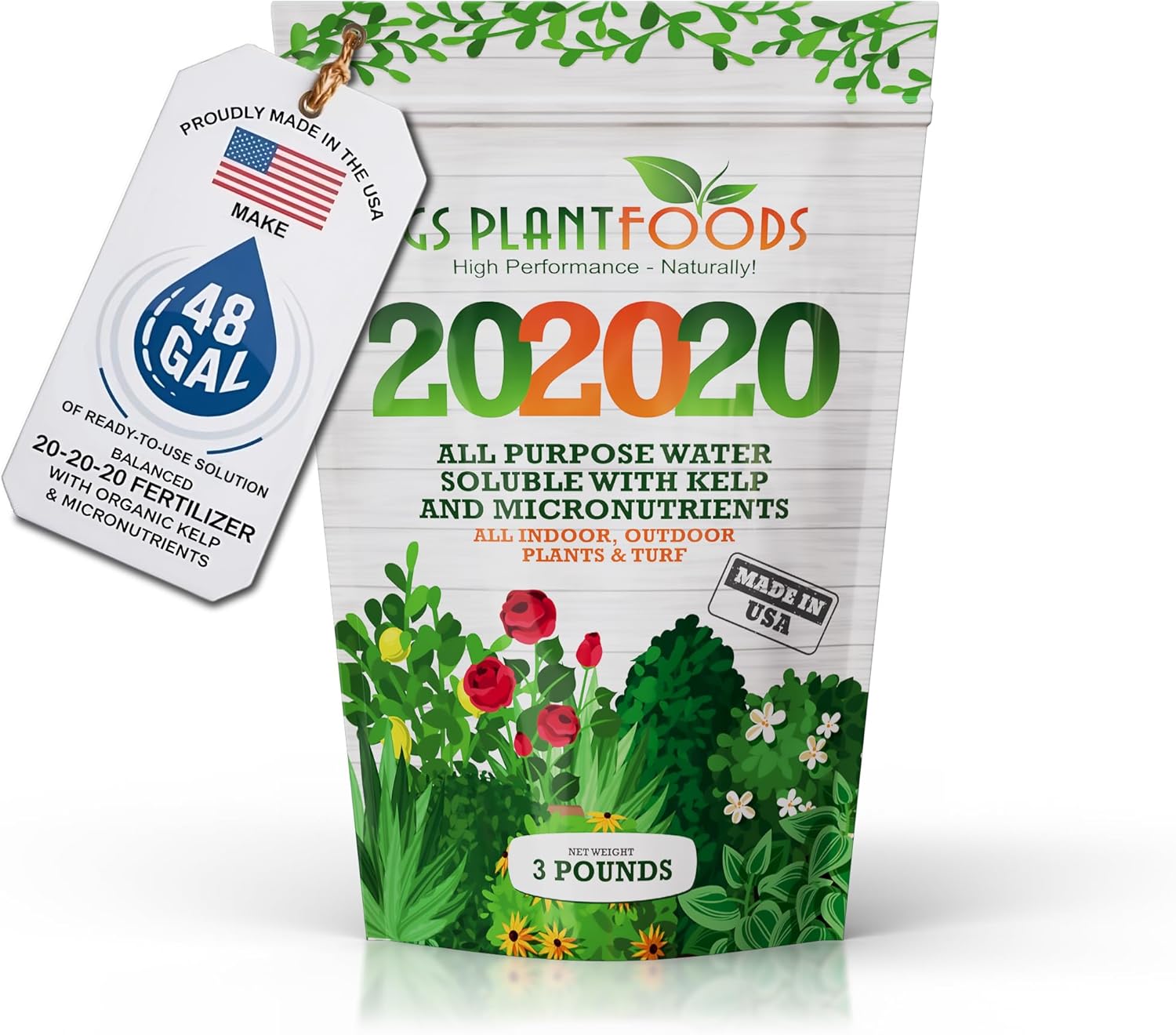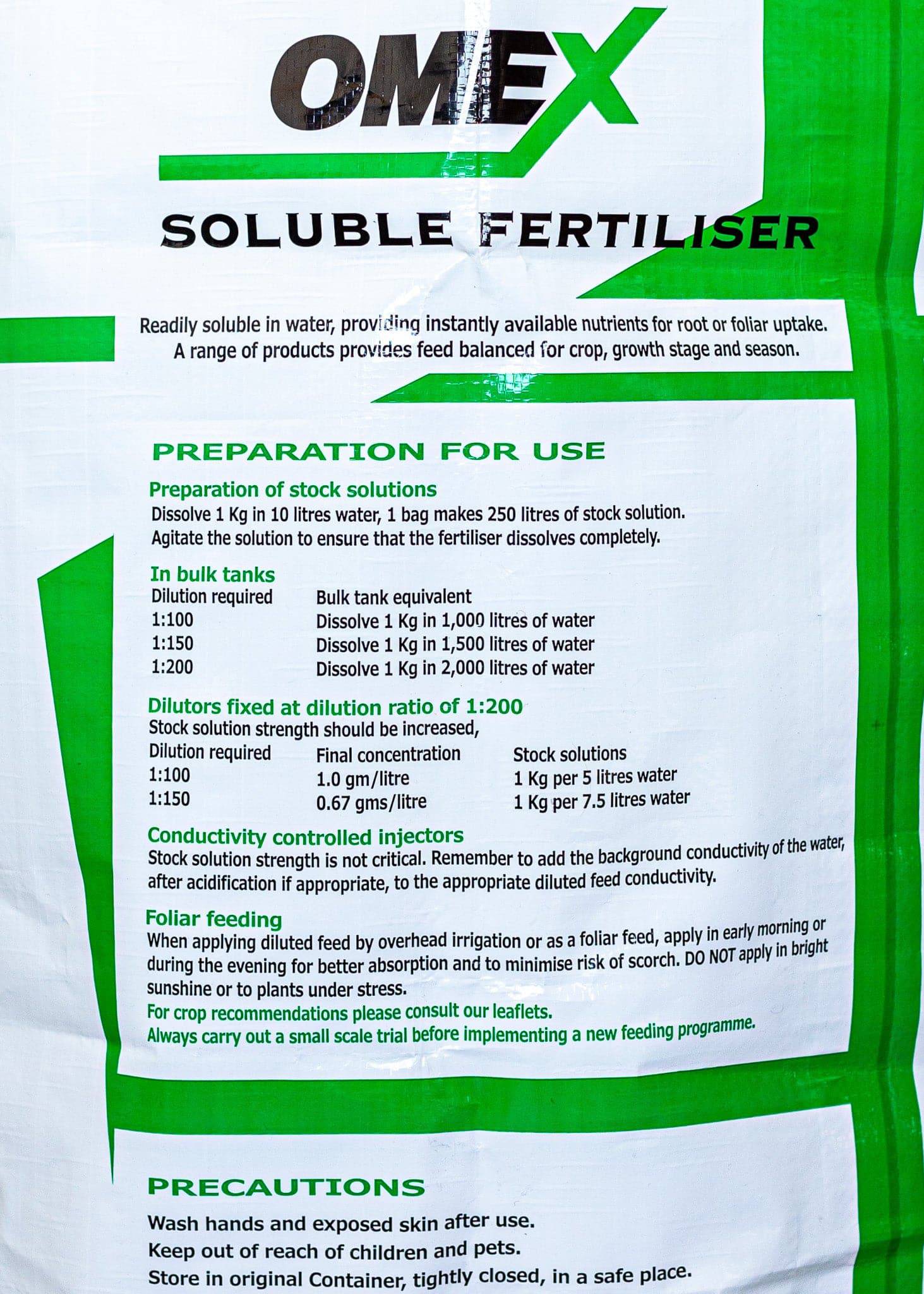How Often Should I Use 20/20/20 Fertilizer for Vegetables? A Comprehensive Guide for Gardeners

Fertilizing your vegetable garden is crucial for promoting healthy growth and maximizing yield. One popular option among gardeners is the 20/20/20 fertilizer, which provides a balanced mix of essential nutrients—nitrogen, phosphorus, and potassium. However, knowing how often to apply this fertilizer can be challenging. In this comprehensive guide, we will explore the optimal frequency for using 20/20/20 fertilizer, taking into consideration various factors such as plant type, growth stage, and soil conditions. By understanding these aspects, you can effectively enhance the vitality of your vegetables and achieve a thriving garden.
How Often Should I Use 20/20/20 Fertilizer for Vegetables?
Using 20/20/20 fertilizer for vegetables can significantly boost their growth and yield. It is generally recommended to apply this fertilizer every 4 to 6 weeks during the growing season. However, this can vary depending on factors such as the specific vegetable being cultivated, soil quality, and overall plant health. Before applying, it is wise to observe the plants for signs of nutrient deficiency, which may indicate a need for more frequent applications. Additionally, always follow the manufacturer's instructions regarding dilution and application rates to avoid over-fertilization.
What is 20/20/20 Fertilizer?
The 20/20/20 fertilizer is a well-balanced, all-purpose fertilizer containing equal proportions of nitrogen, phosphorus, and potassium (NPK). This balanced ratio makes it ideal for supporting healthy plant growth, root development, and flower and fruit production, making it especially advantageous for a variety of vegetables. When used according to guidelines, it helps ensure that plants receive the essential nutrients they require throughout their growth cycle.
Signs Your Vegetables Need Fertilization
Vegetables may require additional fertilization if you notice yellowing leaves, stunted growth, or poor production of flowers and fruits. These signs can indicate that your plants are lacking essential nutrients, which can be remedied by the application of 20/20/20 fertilizer. Regularly monitoring your garden and understanding the specific needs of your plants can guide you on when to apply this fertilizer effectively.
Soil Testing for Nutrient Levels
Conducting a soil test is a valuable practice to determine the nutrient levels in your garden soil. This test will provide insights into the specific deficiencies your soil may have, allowing for a more tailored approach to fertilization. By understanding the nutrient composition, you can decide not only when to apply 20/20/20 fertilizer but also how much is necessary for optimal vegetable growth.
Application Methods for 20/20/20 Fertilizer
There are several application methods for 20/20/20 fertilizer, including broadcasting, side dressing, and mixing with water for fertigation. Broadcasting involves evenly spreading the granules over the soil, while side dressing is the method of applying fertilizer alongside growing plants. Fertigation blends the fertilizer with the irrigation system, allowing for even distribution. Each method can be effective, so choose the one that best fits your gardening style and vegetable needs.
Pest and Disease Management While Using Fertilizer
When applying 20/20/20 fertilizer, it is crucial to monitor for pests and diseases, as overly vigorous growth can attract unwanted insects or lead to susceptibility to fungal infections. Healthy plants are more resilient, but in some cases, pests can thrive in nutrient-rich environments. Regular inspections and integrated pest management strategies will help keep your garden healthy while making the most of your fertilization efforts.
| Activity | Frequency |
|---|---|
| Fertilization | Every 4-6 weeks during growing season |
| Soil Testing | Once per season or as needed |
| Pest Monitoring | Weekly or bi-weekly |
| Watering | As needed based on moisture levels |
How often should I put fertilizer on vegetables?

To determine how often you should put fertilizer on vegetables, it is crucial to consider several factors, including the type of vegetable, the stage of growth, and the type of fertilizer used. Generally, vegetables benefit from fertilization once every 4 to 6 weeks during the growing season. However, it is essential to follow specific guidelines to ensure optimal growth and health of the plants.
Understanding Different Types of Fertilizers
Different types of fertilizers serve various purposes and have varied application frequencies:
- Granular fertilizers are often slow-release and may only be needed every 6 to 8 weeks.
- Liquid fertilizers provide immediate nutrients and can be used every 2 to 4 weeks.
- Organic fertilizers, such as compost or manure, can be applied as needed, typically every month during the active growing season.
Vegetable Growth Stages
The growth stage of your vegetables significantly impacts fertilization needs:
- During the seedling stage, it’s advisable to use a weaker fertilizer solution for gentle nurturing.
- Once plants enter the vegetative stage, they benefit from higher nutrient concentrations, requiring more frequent feedings.
- In the fruiting stage, a balance of nitrogen, phosphorus, and potassium is crucial, and fertilization may be increased.
Soil Testing for Nutrient Needs
Conducting a soil test helps you understand the specific nutrient requirements for your garden:
- pH levels affect how plants absorb nutrients, and the right pH can enhance fertilizer efficiency.
- Testing for macronutrients like nitrogen, phosphorus, and potassium can guide your fertilization schedule.
- Micronutrient deficiencies, such as iron or magnesium, may necessitate tailored fertilization more frequently.
Seasonal Considerations
The season can influence how often to apply fertilizer:
- During spring, as plants grow more actively, frequent fertilization is beneficial.
- Summer may require regular feeding to support continual growth, especially in high-yielding crops.
- As temperatures cool in autumn, reduce fertilization frequency, preparing plants for dormancy.
Signs Your Vegetables Need More Fertilizer
Regularly monitor your plants for signs of nutrient deficiencies:
- Yellowing leaves may indicate a nitrogen deficiency, suggesting it's time to fertilize.
- If plants are stunted or have poor growth, it could signal a lack of essential nutrients.
- Look for Purple hues on leaves or stems, which can indicate phosphorus deficiency.
What plants benefit from 20-20-20 fertilizer?

20-20-20 fertilizer is a balanced, all-purpose fertilizer that contains equal parts nitrogen, phosphorus, and potassium, making it highly beneficial for a variety of plants. The ratio 20-20-20 signifies that each of these essential nutrients is present in 20% concentration. This type of fertilizer is particularly useful for promoting overall growth, enhancing flowering, and improving fruiting in plants. Here are some plants that typically benefit from 20-20-20 fertilizer:
Annual Flowers
Annual flowers, such as petunias, marigolds, and geraniums, thrive on the balanced nutrition provided by 20-20-20 fertilizer. These flowers need a steady supply of nutrients throughout their growing season to produce vibrant blooms and robust foliage.
- Petunias: These flowers benefit from regular feeding to maintain their colors and vigor.
- Marigolds: Known for their pest-repelling properties, marigolds respond well to the nutrient boost.
- Geraniums: They require balanced nutrients for healthy growth and prolific flowering.
Vegetable Gardens
In vegetable gardens, 20-20-20 fertilizer is ideal for a diverse range of crops. Vegetables such as tomatoes, peppers, and cucumbers will flourish with the consistent nutrient supply that supports their growth cycles from seedling to harvest.
- Tomatoes: Demand high nutrient levels during flowering and fruit setting.
- Pepper plants: Require balanced nutrients for healthy foliage and fruit production.
- Cucumbers: Benefit from the enhanced growth that 20-20-20 fertilizer provides.
Tropical Plants
Tropical plants, which often require rich nutrients to mimic their natural growing conditions, respond exceptionally well to 20-20-20 fertilizer. Plants like hibiscus and bougainvillea exhibit improved growth and flowering when adequately nourished.
- Hibiscus: Flourishes with balanced nutrients, resulting in larger blooms.
- Bougainvillea: Thrives with consistent feeding, promoting vibrant bracts.
- Palms: Require substantial nutrients for healthy fronds and overall vitality.
Indoor Houseplants
Indoor houseplants also benefit from 20-20-20 fertilizer, as many species thrive on rich, balanced nutrition. For example, peace lilies and pothos can exhibit enhanced growth and lush foliage when given this fertilizer.
- Peace Lilies: Enjoys the nutrient support for dense foliage and stunning blooms.
- Pothos: Grows prolifically with balanced feeding, enhancing trailing growth.
- Spider Plants: Flourish with the right level of nutrients, leading to vibrant, healthy plants.
Fruit Trees
Fruit trees, such as apple and peach trees, can thrive with the application of 20-20-20 fertilizer, which helps them establish strong root systems and produce abundant fruit. Proper feeding during their growing season is essential for optimal yield.
- Apple trees: Benefit from a nutrient boost for better fruit development.
- Peach trees: Require balanced nutrition for enhanced flowering and fruit set.
- Citrus trees: Thrive with the consistent nutrients to promote healthy fruit growth.
What is the 20/20-20 rule for fertilizer?

The 20/20-20 rule for fertilizer is a guideline used in gardening and agriculture to optimize plant growth and health by balancing the essential nutrients provided to plants. This rule refers specifically to a type of fertilizer that has an equal ratio of nitrogen (N), phosphorus (P), and potassium (K), each represented by the numbers in the fertilizer's N-P-K ratio, which is 20-20-20. This means that each of the three primary nutrients is present in a concentration of 20%.
In practical terms, using a 20-20-20 fertilizer can benefit a wide range of plants, including flowers, vegetables, and shrubs, as it promotes vigorous growth by ensuring that plants receive a balanced amount of these key nutrients.
The Importance of Nitrogen, Phosphorus, and Potassium
Nitrogen, phosphorus, and potassium are essential nutrients that help plants thrive. Each plays a distinct role in plant development:
- Nitrogen: Critical for leaf and stem growth, nitrogen is a vital component of chlorophyll, which plants use for photosynthesis.
- Phosphorus: Key for root development and flower formation, phosphorus is important for energy transfer within the plant.
- Potassium: Enhances overall plant health and disease resistance, potassium plays a role in regulating various physiological functions, including water uptake.
When to Use 20/20-20 Fertilizer
The 20/20-20 fertilizer can be particularly beneficial during specific stages of plant growth. Its timing and application method are crucial for maximizing its effectiveness:
- Early Growth Stages: It is ideal during seedlings or young plants to support rapid growth.
- Flowering Period: Using it during flowering can help increase bloom development and fruit set.
- General Maintenance: Regular application can help maintain nutrient levels in the soil throughout the growing season.
How to Apply 20/20-20 Fertilizer
Applying 20/20-20 fertilizer requires some planning to ensure that it benefits plants without causing harm. Here are some key steps:
- Read Instructions: Always follow the manufacturer's guidelines on dosage and frequency.
- Soil Assessment: Conduct a soil test before application to know the nutrient levels present.
- Watering: Water the plants before and after applying the fertilizer to promote effective nutrient absorption.
Potential Risks of Over-Fertilization
While fertilizers like 20/20-20 can enhance plant growth, over-application can lead to several problems:
- Nutrient Burn: Excessive fertilizer may cause burns to plant roots and leaves, leading to plant stress.
- Environmental Impact: Runoff from over-fertilized areas can lead to water pollution and harm aquatic ecosystems.
- Soil Imbalance: Over time, too much fertilizer can disrupt the natural balance of soil nutrients.
Best Practices for Fertilizer Use
To ensure that 20/20-20 fertilizer is used effectively and sustainably, it's helpful to follow some best practices:
- Follow a Schedule: Create a fertilization schedule tailored to your plants’ specific needs and growth cycle.
- Balance with Organic Matter: Incorporate organic matter to enhance soil health along with using synthetic fertilizers.
- Monitor Plant Health: Regularly check plants for signs of nutrient deficiencies or excesses and adjust your fertilization practices accordingly.
Can you use 20-20-20 fertilizer on tomato plants?

Yes, you can use 20-20-20 fertilizer on tomato plants. This type of fertilizer is known as a balanced fertilizer, containing equal parts of nitrogen, phosphorus, and potassium. These three nutrients play vital roles in the growth and health of tomato plants.
Tomato plants require significant amounts of nitrogen for healthy leaf and stem growth, phosphorus for strong root development and flowering, and potassium for overall plant health and fruit quality. Using a balanced fertilizer such as 20-20-20 can help provide the essential nutrients that tomatoes need throughout their growth stages.
However, it is essential to apply this fertilizer correctly to avoid potential harm to the plants. Over-fertilizing can lead to nutrient burn, which can damage the roots and halt growth. Therefore, following the application's instructions and observing the plants' responses is crucial for successful gardening.
Understanding 20-20-20 Fertilizer
20-20-20 fertilizer is a water-soluble formula that makes nutrients readily available to plants. It is often used for general gardening purposes due to its balanced nutrient profile. The use can be summarized as follows:
- Nitrogen: Promotes lush, green foliage.
- Phosphorus: Encourages root and flower development.
- Potassium: Supports plant metabolism and stress tolerance.
When to Apply 20-20-20 Fertilizer
Timing is critical for the successful application of 20-20-20 fertilizer. Tomato plants benefit from fertilization at different growth stages, particularly:
- Before Planting: Incorporate into the soil to prepare for optimal growth.
- During Growth: Dilute and apply every 4-6 weeks during the growing season.
- Post-Flowering: Use sparingly to avoid over-fertilization as tomatoes begin to set fruit.
How to Apply 20-20-20 Fertilizer
Proper application of 20-20-20 fertilizer ensures that your tomato plants get the most benefit. Here’s how to do it effectively:
- Dilution: Mix the fertilizer with water according to the manufacturer's instructions.
- Application Method: Use a watering can or garden sprayer to apply directly to the soil around the plants, avoiding the leaves.
- Watering: Ensure the plants are watered well before and after applying fertilizer to aid nutrient uptake.
Benefits of Using 20-20-20 Fertilizer on Tomato Plants
The application of 20-20-20 fertilizer can provide several benefits to your tomato plants, including:
- Enhanced Growth: Promotes vigorous growth and healthy foliage.
- Improved Fruit Quality: Encourages the development of larger and more flavorful tomatoes.
- Stress Resistance: Helps plants to withstand environmental stresses.
Potential Issues with Over-Fertilization
While 20-20-20 fertilizer can be beneficial, over-fertilization poses risks that gardeners should be aware of:
- Nutrient Burn: Symptoms include browning leaf tips and wilting.
- Imbalanced Soil: Excess nutrients can harm beneficial soil organisms and affect plant health.
- Fruit Issues: Excess nitrogen can result in poor fruit set and lower quality.
Questions from Our Readers
How often should I apply 20/20/20 fertilizer to my vegetable garden?
Using 20/20/20 fertilizer should be done every 4 to 6 weeks during the growing season to ensure your vegetables receive the necessary nutrients for optimal growth.
Can I apply 20/20/20 fertilizer more frequently?
While it's tempting to apply 20/20/20 fertilizer more often, doing so can lead to nutrient burn and negatively affect plant health, so stick to the recommended schedule for best results.
Is it safe to use 20/20/20 fertilizer for all types of vegetables?
Yes, 20/20/20 fertilizer is generally safe for most vegetables, but it's crucial to monitor your plants for any signs of over-fertilization or nutrient deficiencies to adjust your feeding strategy accordingly.
What should I do if my vegetables show signs of nutrient deficiency?
If your vegetables display symptoms of nutrient deficiency, consider conducting a soil test and adjusting the application rate of your 20/20/20 fertilizer or supplementing with specific nutrients to address the issue.

If you want to read more articles like How Often Should I Use 20/20/20 Fertilizer for Vegetables? A Comprehensive Guide for Gardeners, we recommend you check out our Fertilised category.
Leave a Reply